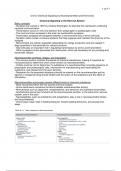Class notes
Chapter 3: Chemical Signalling by Neurotransmitters and Hormones
- Course
- PSYC 450 (PSYC450)
- Institution
- Athabasca University (AU )
Chapter 3 delves into the intricate mechanisms of chemical signalling by neurotransmitters and hormones within the nervous system. It begins with the basic concepts of synaptic transmission, highlighting the directionality from presynaptic to postsynaptic cells and the structural components of syna...
[Show more]



